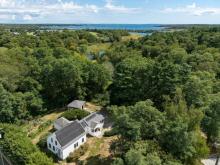Wareham loses a quiet, but important advocate
Friends and family members remember Bob "Grumpy" Conway as quiet and private. He never drew attention to himself or talked about his needs or wants. Conway dedicated himself instead to addressing the wants and needs of others, including those who had no voice to speak: specifically, the flora and fauna of the cranberry bogs where Conway spent the past forty years as an employee of A.D. Makepeace.
"He wanted to know everything about his environment, and his environment was his world around the Makepeace bog," said Joanne "Joey" Mason. She met Conway in 1989, when he guided her through the Makepeace bogs to erect nesting boxes for kestrels, a small falcon that requires open space to hunt.
"I didn't get the impression that he knew that much about birds when I first met him. He kind of tried to make me think he was reluctant to [show me around]... but it was clear he enjoyed it," Mason continued, speculating that this pretend gruffness may have been the cause of his nickname "Grumpy." "But his knowledge just blossomed. After he felt comfortable with birds, he moved on to flowers, then butterflies...The outdoors was basically his church, and that was his joy in life - going around to see what was happening."
Conway's observations, which he emailed to friends every day, were highly valued by the conservation community. Even though he was completely self-taught, used his own abbreviations and frequently eschewed punctuation, Conways notes included acute scientific observations mixed in with a local woodsman's folk wisdom.
"Shoestring resv +25 swans 19 blks 5 widgeon 4 ringnecks 3 hd mergs 9mallards
Geese & ducks are very skittish in places as central zone season for geese is still open til the 15th," he wrote in his last email on Feb. 12, indicating that he had observed least 25 swans, 19 Black ducks, 5 American widgeons, 4 Ring-necked ducks, 3 hooded mergansers, and 9 mallards at the Mashpee Reservation near Shoestring Bay. Just hours later, he would suffer a heart attack while working on the bogs.
"His emails were so interesting, but so hard to read!" said Betty Anderson, a local award-winning birder, and the founder of the Manomet Bird Observatory. "It took me awhile to get used to them... But he was just so observant and so knowledgable. He was one of the finest naturalists I've ever known for Southeast Massachusetts."
Conway's continual and careful monitoring of others' needs, was something that he exhibited his entire life, said his younger sister Claire Smith of Wareham. "He was never married, never had children, but checked every day to see if everything was good. He was a very private person, but I've come to realize that he had a larger, extended family. That's how he viewed his friends. They were part of his family."
The Makepeace bogs and their inhabitants also became a part of that family.
"In many respects, Bob was the environmental conscience of the company," said Michael P. Hogan, president and CEO of the A.D. Makepeace Company. Conway regularly guided visitors - whether school groups, land conservationists, scientists, and even emergency workers, through the Makepeace bogs, imparting his knowledge of the terrain.
Conway said that the animals could distinguish his truck from the other Makepeace vehicles, allowing him to snap his award-winning photographs and observe the wildlife's habits. Anderson would compile Conway's records of birds and send them to the Massachusetts Audubon Society for their Breeding Bird Atlas. Conway also could identify many of the pairs that migrated annually to the bogs to raise their young.
"He would find something unique going on in the wild, and he would call and say, 'got a minute?'" recalled Mack Phinney, a fellow conservationist and friend of Conway's. "He'd say 'meet me at such-and such - usually some bog, and he would show me something."
One of Conway's most memorable discoveries was a family of Sandhill cranes.
"The first time he took a picture and showed me, I wasn't sure," said Phinney, explaining that Sandhill cranes rarely range east of the Appalachian Mountains. "But he's been tracking them for twelve years."
They are a fitting discovery for Conway. Like the cranes, Bob Conway was a rare but very special visitor to Wareham's cranberry bogs.
"He opened his eyes wider than anybody," said friend Rebecca Lipton. "And he got a closer look at nature every day than most people get in a lifetime."














